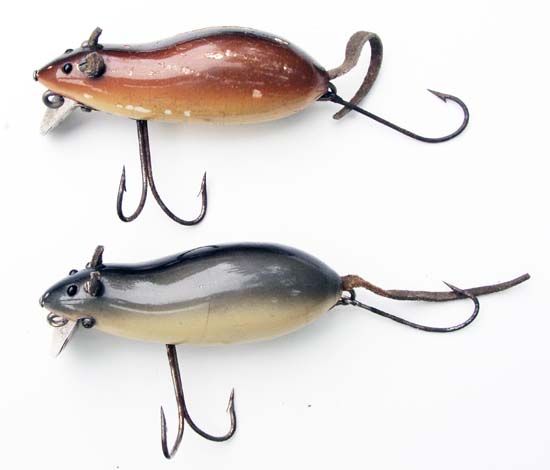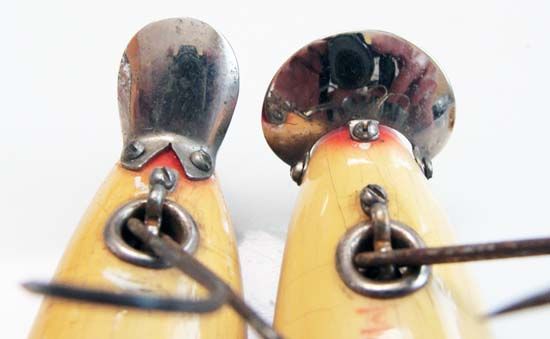
This ad from the May 1929 issue of Field & Stream introduces the Heddon Meadow Mouse. I recall as a youngster seeing the early version this lure for the first time in an older gentleman's tackle box. Its leather ears, leather tail, pointed nose and small beady eyes really impressed me. I thought now that really looks like a mouse. Apparently it impressed quite a few fisherman as despite being introduced at the beginning of the Great Depression, it is not particularly rare.

By the time I was old enough to buy one for my own tackle box (I’m thinking this was 1956) the lure was made of Tenite with molded ears. It still had a leather tail and with a gray flocked finish it looked more like a mouse than any other plug I had ever seen on the shelf at the local hardware store. That’s pretty much where my positive impressions of the bait ended. It did not have a particularly impressive wiggle as is swam across (or just under) the surface. I did not catch a single fish on it. I lost the lure a few years later and I was never inspired to replace it. As an avid reader of Jason Lucas, the fishing editor of Sports Afield, my opinion was bolstered in the early 1960s when he wrote in his column that lures that appeal to fisherman are not always the same ones that appeal to the fish. I believe in the article he was talking about the Pikie Minnow, a lure that keeps on catching fish despite a somewhat modest wiggle. Another example he used to illustrate the point was comparing two swimming mice lures. One looked very much like a real mouse (think Heddon here) and another mouse that didn’t look all that realistic (think Shakespeare here). He stated that the second was a far more effective bait than the more realistic looking version. I knew instantly which lures he was talking about and I have always found his observation to be absolutely true.
It has often been noted that the earliest version of the Heddon Mouse had a single hook on the rear rather than a treble and a much smaller metal lip than later versions. In fact it used the same metal lip as another bait introduced in 1929, the 110 wooden River Runt. I believe that the single rear hook was part of an effort to make this early version of the Mouse swim with a more pronounced wiggle as the shape of the wooden body, while looking very much like a mouse, prevented the kind of swimming action that the 110 River Runt demonstrated. Fairly early this problem was addressed with a new metal lip, one that was similar to the metal lip on Heddon’s successful Vamp bait. While appearing very similar to the Vamp lip, it is a downsized version, which you will find out if you ever try to replace one with the other. I found this out the hard way some years back when I acquired a large batch of experimental baits from the Heddon factory. These were baits that they had tried different hardware on, such as an SOS body with a 210 collar, a Zaragossa with a 210 collar and an 1800 Crab Wiggler with the standard diving lip on one end and a 210 collar on the other and a line tie on each end making it a reversible lure. Many other lures had holes drilled in them and impressions in the paint where one could tell what type of hardware they had tried out,then removed. There was a 110 River Runt body in the white that had been drilled to accept the second version of the mouse diving lip. Those were the only holes in the bait. I had and extra Vamp lip which I attempted to install and soon found out that none of the holes matched up. After comparing the lip of a Vamp with one on a Heddon Mouse it became instantly clear that the second was smaller than the first. It also told me that Heddon had experimented with using the new mouse lip on the wooden River Runt body. Sometime after the change in diving lips on the mouse, the rear single hook was replaced with a treble.


I visited the home of Heddon expert and collector Bill Roberts in Birmingham, Alabama about 15 ago. In addition to the greatest Heddon collection I’ve ever seen, he was showing me some beautiful antique cars in the basement of his home when I noticed a folding table with several well used Heddon Meadow Mice on it. I asked what the deal was with them and Bill said he regularly fished with them. I told him he was the only person I knew who fished with them. He said he had done fairly well on them and like me, he enjoyed fishing with antique baits. He then proceeded to tell me a very memorable story which I will attempt to do justice to here.
He and a friend were in their boat moving slowly along a lake shore casting around docks. Bill cast a Heddon Meadow Mouse very near the shore when out of nowhere a large “Tom Cat” dashed out and pounced on the bait and was immediately, solidly hooked. Bill said that after reeling this very irate cat through the water to the boat they netted it with a large landing net. The picture he verbally painted of he and his partner on their hands and knees pinning this cat to the floor of the boat with the landing net while trying with pliers to unhook the berserk feline is one I will never forget. I told him he should write up a complete version of the story as I had the perfect title for him ----”What Real Catfishing Is Like”
Tight Lines,
Bill S
Post script: Some time after writing this article I was thinking I should refresh my recollections of how a Heddon Meadow Mouse swims in the water. I proceeded to the end of the dock last evening and took three cast, the last of which is was devoured by a bass of 14 inches. Wondering if maybe my judgment on how effective this lure is was a bit hasty, I jumped into the row boat and drifted down the lake for an hour casting in all directions. I never received a hit. Pulling up to the dock at dusk I laid the rod on the dock while tying up the boat. Just as I got the first of two lines tied to a cleat a tremendous splash occurred just four feet away at the end of the dock. Investigation showed that I had laid the rod on the end of the dock with just enough line out that one fourth of the Meadow Mouse was hanging in the water where a bass had tried his best to make off with it. Apparently the jury is still out ---LOL
===========================================
BUY THE DECONSTRUCTING OLD ADS (VOLUME 1) BOOK BY CLICKING HERE!

No comments:
Post a Comment